
The subphylum Chelicerata constitutes one of the major subdivisions of the phylum Arthropoda. It contains the sea spiders, arachnids, and several extinct lineages, such as the eurypterids and chasmataspidids.
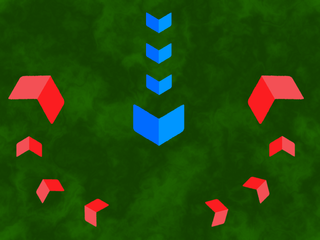
The pincer movement, or double envelopment, is a military maneuver in which forces simultaneously attack both flanks (sides) of an enemy formation. This classic maneuver holds an important foothold throughout the history of warfare.

A pseudoscorpion, also known as a false scorpion or book scorpion, is an arachnid belonging to the order Pseudoscorpiones, also known as Pseudoscorpionida or Chelonethida.

Amblypygi is an ancient order of arachnid chelicerate arthropods also known as whip spiders and tailless whip scorpions. The name "amblypygid" means "blunt tail", a reference to a lack of the flagellum that is otherwise seen in whip scorpions. They are harmless to humans. Amblypygids possess no silk glands or venomous fangs. They rarely bite if threatened, but can grab fingers with their pedipalps, resulting in thorn-like puncture injuries.

Thelyphonida is an arachnid order comprising invertebrates commonly known as whip scorpions or vinegaroons. They are often called uropygids in the scientific community based on an alternative name for the order, Uropygi. The name "whip scorpion" refers to their resemblance to true scorpions and possession of a whiplike tail, and "vinegaroon" refers to their ability when attacked to discharge an offensive, vinegar-smelling liquid, which contains acetic acid.

Ricinulei is an order of arachnids. Like most arachnids, they are predatory, eating small arthropods. In older works they are sometimes referred to as Podogona.
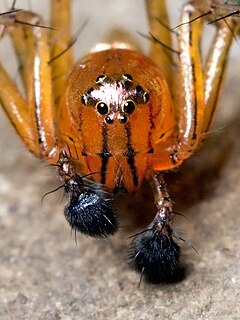
Pedipalps are the second pair of appendages of chelicerates – a group of arthropods including spiders, scorpions, horseshoe crabs, and sea spiders. The pedipalps are lateral to the chelicerae ("jaws") and anterior to the first pair of walking legs.

Solifugae is an order of animals in the class Arachnida known variously as camel spiders, wind scorpions, sun spiders, or solifuges. The order includes more than 1,000 described species in about 153 genera. Despite the common names, they are neither true scorpions nor true spiders. Most species of Solifugae live in dry climates and feed opportunistically on ground-dwelling arthropods and other small animals. The largest species grow to a length of 12–15 cm (5–6 in), including legs. A number of urban legends exaggerate the size and speed of the Solifugae, and their potential danger to humans, which is negligible.

Xiphosura is an order of arthropods related to arachnids. They are sometimes called horseshoe crabs. They first appeared in the Hirnantian. Currently, there are only four living species. Xiphosura contains one suborder, Xiphosurida, and several stem-genera.
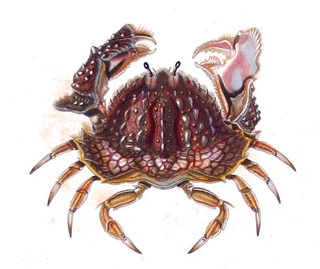
Calappa hepatica, the reef box crab, is a common benthic species of box crab of tropical and subtropical parts of the Indian and Pacific Oceans and the Red Sea.
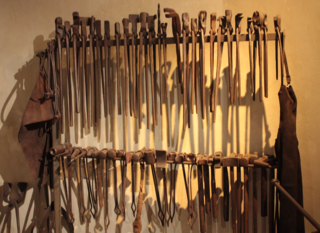
Pincers are a hand tool used in many situations where a mechanical advantage is required to pinch, cut or pull an object. Pincers are first-class levers, but differ from pliers in that the concentration of force is either to a point, or to an edge perpendicular to the length of the tool. This allows pincers to be brought close to a surface, which is often required when working with nails.

Mastigoproctus giganteus, the giant whip scorpion, also called the giant vinegaroon or grampus, is a species of whip scorpions in the family Thelyphonidae.
This glossary describes the terms used in formal descriptions of spiders; where applicable these terms are used in describing other arachnids.

A chela, also named claw, nipper, or pincer, is a pincer-like organ at the end of certain limbs of some arthropods. The name comes from Greek through New Latin. The plural form is chelae. Legs bearing a chela are called chelipeds. Another name is claw because most chelae are curved and have a sharp point like a claw.

Calappa japonica, also known as the Japanese shame-faced crab, is a marine species of box crab in the family Calappidae. Originally found in the waters around Japan, more recently it has been found in Africa, the Red Sea and Western Australia.

Neobisiidae is a family of pseudoscorpions distributed throughout Africa, the Americas and Eurasia and consist of 550 species in 32 genera. Some species live in caves while some are surface-dwelling.
Tokummia katalepsis is a fossil arthropod from the Burgess Shale as found in a quarry in Marble Canyon in Canada. It is an early member of Mandibulata. The fossil is 508 million years old. The animal has maxillipeds, mandibles, ring-shaped body segments, and subdivided basipods. At the front of the animal are mandibles with pincers. This is the oldest fossil with pincers. The speculation is that T. katalepsis grabbed soft bodied prey with the mandibles and them chopped them into pieces so that it could eat. It has more than 50 pairs of legs. The animal is about 10 cm long and has a two piece carapace on its back. It was a bottom feeder, being able to walk on the sea floor, and to occasionally swim. The animal legs have endites which are small spikes on the legs. It has one pair of antennae.
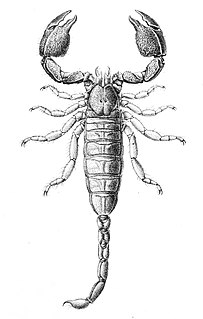
Cheloctonus jonesii is a species of scorpion in the family Hormuridae native to southern Africa.

The subcapitulum, also known as infracapitulum, hypognathum or hipognatum, refers to the ventral part of the gnathosoma or the fusion of the palpal coxae and the labrum complex present in some arthropods on which the mouth, pedipalps, mouthparts and pharynx are generally located. It is delimited by the subcapitular apodeme, which separates it from the cheliceral frame.

















